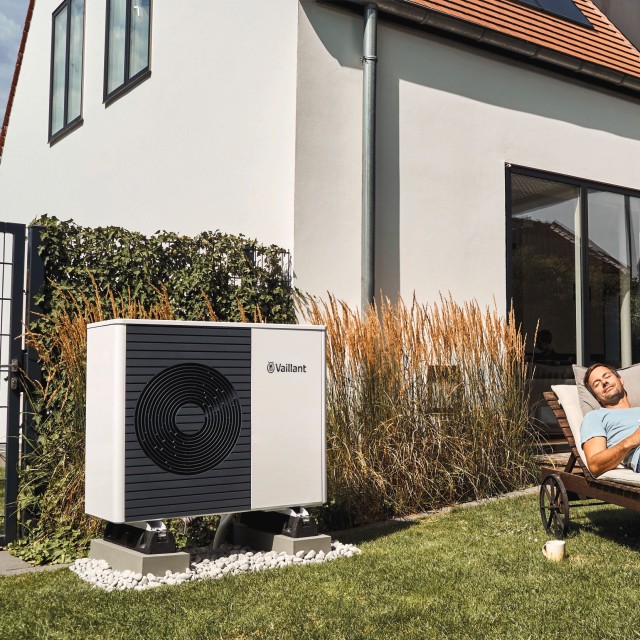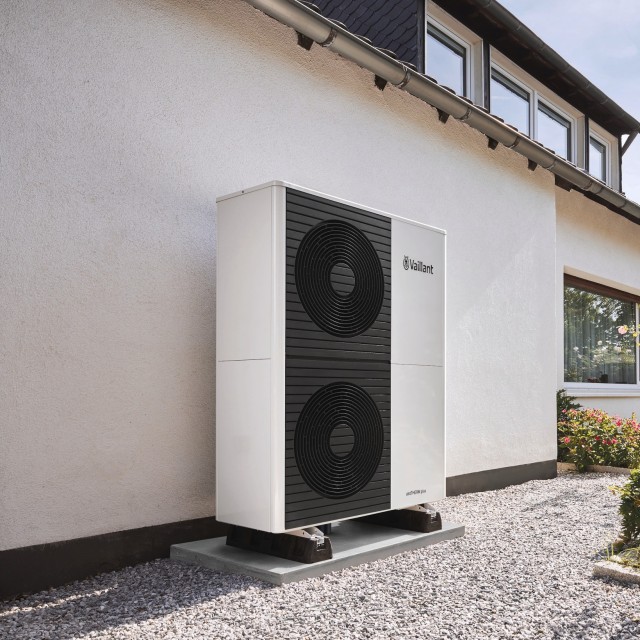Weather Compensation Control sensoCOMFORT
The intuitive control to manage your heating and hot water
-
Control

Are you thinking about making the switch to a heat pump? Good Choice! Heat pumps are a sustainable, energy efficient solution that provides both heating and hot water. They are designed for long-lasting performance with minimal maintenance.

When asking, ‘What size heat pump do I need?’ you are referring to its power output, measured in kilowatts (kW). This indicates how much energy the heat pump can generate for your home.
The size of the heat pump directly impacts its initial cost to purchase and install. Higher power output means a higher cost for both the appliance and its installation.
If you're wondering about the physical size of a heat pump, you’re asking about its dimensions. Heat pumps, particularly air source heat pumps, are generally compact units, about the size of two domestic wheelie bins, so they won’t take up too much space.
However, you still need to ensure you have enough room for correct installation and airflow.
The size of a heat pump can vary by manufacturer. Below is a breakdown of Vaillant heat pump sizing:
Height (mm) | Width (mm) | Depth (mm) | |
|---|---|---|---|
| aroTHERM plus 3.5kW | 765 | 1,100 | 490 |
| aroTHERM plus 5kW | |||
| aroTHERM plus 7kW | 965 | ||
| aroTHERM plus 10W | 1,565 | ||
| aroTHERM plus 12kW | |||
| aroTHERM split 3.5kW | 765 | ||
| aroTHERM split 5kW | |||
| aroTHERM split 7kW | 965 | ||
| aroTHERM split 10kW | 1,565 | ||
| aroTHERM split 12kW | |||
| aroTHERM 5kW | 840 | 980 | 408 |
| aroTHERM 8kW | 975 | 1,103 | 463 |
| aroTHERM 11kW | |||
| aroTHERM 15kW | 1,380 | ||
| flexoTHERM 5kW | 1,256 | 1,192 | 785 |
| flexoTHERM 8kW | |||
| flexoTHERM 11kW | |||
| flexoTHERM 15kW | |||
| flexoTHERM 19kW |
Heat pumps are rated based on heating and cooling capacities, typically measured in British Thermal Units per hour or tonnes. One tonne is equivalent to 12,000 BTUs per hour. The size of the heat pump you need depends on various factors, including the size of your home, the local climate, insulation levels, and the number of windows and doors.
Your installer will be able to advise on the best heat pump for your property, but factors influencing the size of your heat pump may include:
The larger your home, the more BTUs you will need to maintain a comfortable temperature. Apartment buildings or multi-story homes may require additional consideration, as heat distribution can vary between floors. Air source heat pumps are versatile and can adapt effortlessly to a wide variety of property types.
Is my home suitable for a heat pump? Find out here.The local climate plays a significant role in determining the size of your heat pump. All Vaillant heat pumps have been tested in a variety of climates and can operate in temperatures down to -25°C. Vaillant heat pumps also have salt corrosion protection to aid longevity if your property or heat pump is near the shore.
Discover how heat pumps work in the winter.The correct level of insulation will reduce the load on your heat pump by maintaining the desired temperature more efficiently. Homes with poor insulation will require a larger heat pump to compensate for the heat loss or gain. Cavity wall insulation, double or triple glazing, and loft insulation are all types of insulation that will improve the ErP rating of your property.
Different types of insulation.The number of people in your home and their typical activities can also influence the size of heat pump you need. You should consider how many bathrooms your property has so that your heat pump can meet your heating and hot water needs.
How heat pump energy usage is measured.Whether you're good at maths or not. Choosing the right heat pump size is new territory for all homeowners. That's why you should rely on an expert: Our installers can perform a detailed heat loss calculation and recommend the best heat pump size for your home. They will also know which hot water cylinder and control are right for your needs.
Find out more about how to buy a Vaillant heat pump.

Air source heat pumps are usually installed on the exterior of properties. You may be able to install the heat pump against an exterior wall, but you will need to leave a small gap.
When installing a heat pump outside your property you will need:
Be aware that certain heat pumps, like the aroTHERM plus air source heat pump, use an R290 natural refrigerant which needs certain clearances.
You will need interior space for:
If you are installing a heat pump and are based in the UK, there are government grants available to help make the transition more affordable. These grants can significantly reduce the upfront cost of your new heat pump system.
Take a few minutes to explore the available options and see if you qualify:
Properly sizing your heat pump is key for comfort, energy efficiency, and system longevity.
Consider factors like property size, climate, insulation, and usage to determine the right size for your needs. Consulting a professional ensures you get the best advice and most suitable heat pump. Whether installing a new heat pump or replacing an old one, taking these steps will help you achieve the best results.
An oversized heat pump can lead to short cycling, wasting energy, and reducing lifespan. An undersized heating system struggles to maintain comfort, running continuously and increasing costs.
Properly sized heat pumps offer maximum efficiency, reduced energy bills, consistent comfort, and longer system life, providing peace of mind for years to come.
Absolutely. A qualified installer assesses your home's specific needs, ensuring optimal heat pump performance and efficiency tailored to your property. We have a network Vaillant installers across the country, you can use our 'Find an Installer' tool to discover your local heat pump enginner.